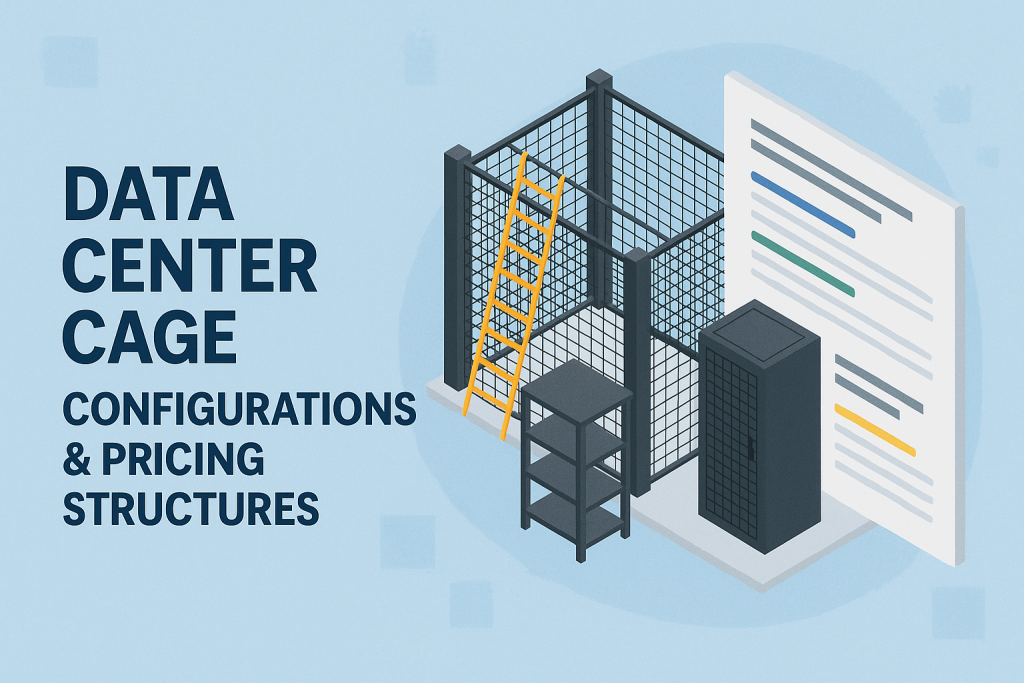As businesses scale their IT infrastructure, choosing the right data center cage configuration and pricing model becomes critical for both operational flexibility and cost efficiency. Whether you’re colocating a few racks or building a high-density environment, understanding how cages are structured and priced helps optimize both capital and operational expenses.
Types of Data Center Cage Configurations
Data center cages are secure, partitioned spaces designed to house a customer’s IT equipment within a shared colocation facility. They can vary based on size, layout, and security level.
Shared Cage (Partial Cage)
- Description: A smaller, secure section of a larger colocation floor shared among multiple tenants.
- Best for: Startups or organizations needing a few racks but still requiring dedicated security.
- Benefits: Lower cost, quick setup, flexible expansion.
- Considerations: Limited customization options and potential shared environmental conditions.
Private Cage
- Description: A fully enclosed, lockable area dedicated to a single customer.
- Best for: Enterprises with strict compliance, security, or regulatory requirements (e.g., HIPAA, PCI-DSS).
- Benefits: Full control over rack layout, cabling, and security; isolation from other tenants.
- Considerations: Higher cost and longer deployment times.
Custom or Modular Cage
- Description: Tailored cage configurations built to meet specific power densities, cooling designs, or footprint needs.
- Best for: Businesses requiring hybrid power arrangements or variable rack densities.
- Benefits: Scalable and adaptable to changing workloads.
- Considerations: Requires planning and coordination with the data center provider.
Flexible Pricing Structures for Data Center Cages
Not all businesses consume space and power in the same way — that’s why modern data centers offer flexible pricing models. Below are three common structures, each with unique advantages depending on your usage profile.
All-Inclusive Flat Rate Model
Example:
A package includes 100 square feet and 10 kW of power for a fixed rate (e.g., $X per month).
How It Works:
Space and power are bundled into a single, predictable monthly cost.
Pros:
- Simplifies budgeting and forecasting.
- No surprises in monthly billing.
- Ideal for stable, consistent workloads.
Cons:
- May be less cost-effective if your actual power usage is below the bundled threshold.
- Less flexibility for variable demand.
Best For:
Enterprises preferring simplicity and predictability in costs — common for long-term contracts and large deployments.
Flat Rate for Space + Variable Power Pricing
Example:
You pay a flat rate for the total cage footprint (e.g., $X per square foot/month) and a separate rate per kW of actual power used.
How It Works:
Space cost is fixed; power charges depend on measured usage or allocated capacity.
Pros:
- More transparency in energy consumption.
- Flexible scaling — pay for what you use.
- Better suited for varying or seasonal workloads.
Cons:
- Monthly bills fluctuate with power consumption.
- Requires monitoring and forecasting of power draw.
Best For:
Cloud providers, SaaS companies, or enterprises with variable workloads or evolving infrastructure.
Pay-Per-Use: Per Square Foot + Per kW Model
Example:
Charges are applied separately — e.g., $Y per square foot and $Z per kW used.
How It Works:
Space and power are treated as independent resources with distinct pricing metrics.
Pros:
- Maximum flexibility and granularity.
- Encourages energy efficiency and optimization.
- Easier to model cost-per-rack or per-application.
Cons:
- Can be complex to predict total costs.
- Requires more detailed operational tracking.
Best For:
Colocation customers seeking fine-tuned control over costs and resources, or those with hybrid IT strategies.
Choosing the Right Model
When evaluating cage and pricing configurations, consider these factors:
- Power Density: How much power your IT load consumes per rack or per square foot.
- Growth Forecast: Whether you’ll scale up power or space over time.
- Budget Stability vs. Flexibility: Do you prioritize predictable costs or variable, usage-based billing?
- Operational Model: Enterprise vs. cloud-native workloads require different levels of flexibility.
Final Thoughts
The evolution of data center pricing models mirrors the shift toward flexibility and efficiency in modern IT. Whether you prefer an all-in-one package for simplicity or a granular per-kilowatt model for precision, the right approach aligns your IT needs with your financial strategy.


